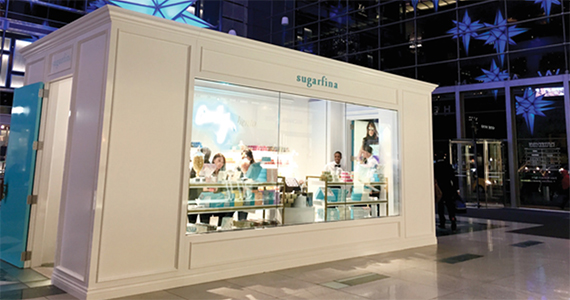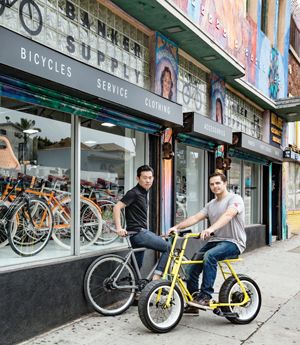Trending
Retail’s new sweet spot

From the retail issue: Why endure the weeklong pain of a cold-pressed juice cleanse when there’s now a seven-day gummy bear cleanse?
The tongue-in-cheek confection — “green juice” gummy bears packed inside Pressed Juicery bottles — is the love child of Beverly Hills gourmet candy shop Sugarfina and Santa Monica juice maker Pressed Juicery.
It was a hit when it launched last month in Sugarfina stores and online. The special gummy bear cleanse package sold out in three hours, with a wait list growing to more than 300 after its first day on the market.
While established retailers shutter stores across the country and file for bankruptcy, rising stars like Sugarfina are shining bright — and causing many developers and landlords to rethink how they approach their tenant mix.
Sugarfina launched as an e-commerce business in 2012, with the goal of treating adults to gourmet sweets with decidedly mature flavor profiles, from single malt scotch cordials to red velvet caramels. It opened its first brick-and-mortar shop a year later in Beverly Hills.
The company wanted to ditch the plastic bags and metal scoopers found at mall candy stores, said Rosie O’Neill, co-founder of Sugarfina. They also wanted to make shoppers feel more comfortable, and so created a fun, less formal environment compared with high-end confectionery shops.
“From the very beginning, we wanted to be the complete opposite of every candy store in existence,” O’Neill said. “We wanted to do for gift giving and high-end confections what Sephora did for makeup — put it in people’s hands and make it fun and accessible.”
Sugarfina’s candy comes in clear cubes that can be arranged in light blue bento boxes, making it popular for the Instagram generation.
Creating an entertaining retail space with products that offer shoppers a story — a must when marketing to millennials — has helped propel other young brands as well. Los Angeles apparel brand Reformation, Detroit-based accessories brand Shinola and New York indoor cycling chain Flywheel Sports have used these strategies, emerging as the next hot retail tenants.
Mitchell Hernandez of CBRE said retailers are beginning to understand shoppers want an experience and not a hard sell on a product they can just order online.
“I’m going to go into a store because I want to feel different,” he said. “It’s more about the branding and consistency of who they are as a company and less about the four walls.”
Take cycling shop Banker Supply in the Echo Park area of Los Angeles.

Rosie O’Neill and Josh Resnick
Nick Drombosky, founder of Banker Supply, said it was important for him to ditch the traditional merchandising format found at most bike shops and opt for a relaxing atmosphere.
Instead of cramming hundreds of cycles into a tiny space, he and his business partner Julius Brenninkmeijer display just a handful of bikes inside his 2,000-square-foot Echo Park store. They are spaced out so shoppers can touch and view them without assistance. Employees are also required to greet each customer, which cycling analysts told The Real Deal is uncommon, as cycling culture is not exactly known for being friendly — it’s a hobby that thrives on exclusivity.
The bike company also carries only emerging and smaller brands — like Coast Cycles and Brooklyn Bicycle Co. — as opposed to bikes and accessories from major labels such as Trek Bicycle Corp. and Giant Manufacturing Co.
It’s a risky move for a three-year-old retailer operating in an industry where ridership among U.S. adults has remained flat since 1995, according to a study by the National Sporting Goods Association. But Banker Supply, previously headquartered in Pittsburgh, has so far bucked the national trends.
Last year, four out of five bikes sold at its stores were to shoppers buying their first bike as an adult, they reported. At its 1,000-square-foot Pittsburgh store, roughly 70 percent of sales are to women, compared to the estimated national average of 15 percent sales from women typically seen at cycling shops.
“Everything is going the way of the consumer,” Drombosky said. “We as businesses have to get new customers. You can’t just rely on the customers you have to spend more money every year.”
Empty spaces
Retailers that have been slow to adapt to the shifts in consumer spending are learning the hard way.
The industry has seen 14 major retailers file for bankruptcy this year so far, including footwear chain Payless ShoeSource, based in Topeka, Kansas; sporting goods retailer Gander Mountain out of Saint Paul, Minnesota; and women’s apparel store The Limited, headquartered in Columbus, Ohio.
Eighteen retail bankruptcies were reported for the whole of last year, according to research from S&P Global Market Intelligence.
Jim Elder, director of risk services for S&P Global, said in a research note the rise of online shopping has left “financial distress in its wake,” with little sign of a recovery. Other major retailers are hanging by a thread, shuttering hundreds of brick-and-mortar stores to stave off financial ruin.
Closings announced from the start of this year to April 6 total 2,880 retail locations, more than twice the number of closings for the same period last year, according to the Wall Street Journal. If the pace continues, it’s estimated that more than 8,600 locations will close this year, outpacing the number of retail closings during the 2008 recession.
With more empty storefronts on the horizon, developers and landlords are facing an uphill battle. Christopher Maling of Colliers International said it’s become depressing in secondary markets, especially compared with gateway cities such as Los Angeles and Seattle.
“I’ve been involved in a lot of sales in some of those [secondary] markets, and for some of these communities the mall is their community outpost,” Maling said.
New faces
However, many properties are being redeveloped with an emphasis on entertainment. “The new buyers are completely transforming the center and creating a draw,” Maling said. “It will bring people and keep them there.”
 Developers and landlords are now focusing on creating an experience at shopping centers by adding younger brands, including additional restaurants and specialty fitness. Some projects include trampoline parks and zip-lining, like Urban Commons’ $250 million redevelopment project in Long Beach, California, at the site of the historic Queen Mary ship.
Developers and landlords are now focusing on creating an experience at shopping centers by adding younger brands, including additional restaurants and specialty fitness. Some projects include trampoline parks and zip-lining, like Urban Commons’ $250 million redevelopment project in Long Beach, California, at the site of the historic Queen Mary ship.
It’s hard to say which are the hottest retail tenants, but the trend is definitely moving toward experiential brands such as fitness studios and tech companies, Thomas Citron of Newmark Grubb Knight Frank said. He added that it also comes down to where the project is located. “Every project is different,” Citron said. “Hudson Yards is like a city. You’re going to see everything from food and beverage to all the LVMH brands to big-box retailers. So it’s really project-specific, and the demographic is going to set that trend as well.”
Industry insiders told TRD that the retailers drawing the most buzz from shoppers and landlords include Oakland, California-based Blue Bottle Coffee, New York burger joint Shake Shack, Orangetheory Fitness of Boca Raton, Florida, New York-based indoor cycling studio Flywheel and Amsterdam menswear label Suitsupply.
Unlike big-box retailers, these companies are taking a curated approach to their real estate strategy, opting to open a relatively small number of stores.
Sugarfina has 25 boutiques and 15 shop-in-shops at Nordstrom. The company said it plans to open at least 10 more boutiques this year, but “we do not have a goal to open hundreds of stores,” O’Neill said. “We really want to keep it focused and special.”
The company also maintains a smaller footprint, she said, with stores from 600 to 700 square feet. Its 200-square-foot store in Time Warner Center has sales of more than $4,000 a square foot, O’Neill said.
Matthew Fainchtein of Cushman & Wakefield said landlords have taken notice as popular retailers slow their pace on launching new shops. “Landlords are having to be more and more aggressive and creative.”
Revamped approach
Jeff Kreshek of Federal Realty said focusing on a healthy mix of tenants has been the biggest shift for landlords, as opposed to snagging one hot anchor. The change is the result of brand-agnostic shoppers. “People want new,” he said.
Landlords now have to figure out what their competitive edge is, and whether their center has something for everyone.
“What’s killing retail is boredom and indifference,” Kreshek said. “As a landlord … if you can’t answer those questions, you have to start asking yourself, ‘Should I be a retail location anymore?’”
It’s a question Federal Realty faced with its own retail stores at Santana Row, a 1.7-million-square-foot mixed-use center in Silicon Valley it has owned since 1997.

Nick Drombosky and Julius Brenninkmeijer
Kreshek started leasing at the project six years ago and said it was clear Santana’s retail offerings needed to be refreshed.
The shopping center swapped out 36 tenants, roughly 40 percent of its retailers, either through natural expiration or early termination. Shopping center staples like Cole Haan and the Walking Company were replaced by retailers such as Aesop, Bonobos, Kit & Ace, Sephora and Marine Layer.
Drastically changing the retail lineup at Santana Row was a tough endeavor. For the last 30 years, the strategy has been to keep the status quo, Kreshek said. “It’s so contrary to what we’ve all been as professionals conditioned to do, which is to retain, retain, retain,” he said. “Not every project needs an approach like we took at Santana Row, but I would argue that universally change is a good thing.”
James Dion, founder of Chicago retail consulting firm Dionco Inc., said historically developers believed the best way to generate revenue was to keep building new retail spaces. “For years, the mantra of the developer was: If you build it, they will come,” he said. “You are [now] seeing the decimation of ‘blah’ retail and, you know something, rest in peace.”
To make it with today’s consumers, developers and landlords have been forced to take an active approach. Now projects must be focused on retailers with a consistent message, whether they are discount stores or luxury brands, Hernandez of CBRE said. Each retailer should have the same strategy of offering a unique story.
“Everyone is saying, ‘We want something different,’” he said. “What they’re really asking for is, ‘What does this project need to have [as] a unique value proposition so that the customers I’m seeking will come here?’”




